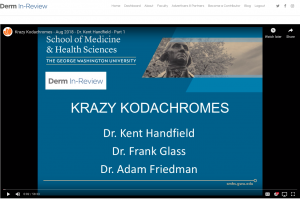One of the biggest issues in dermatology training over the last several years has been the change to the “Exam of the Future” format. The ABD has been applauded for moving away from the older system of boards and in-service exams by having the required components for board certification take place sequentially over the course of residency with the CORE and APPLIED exams. I arrived at my program as part of the first class who would experience this new system of board certification. I was one of the first to take the BASIC exam, the new in-service exam for first years. Truth be told, I didn’t know what to expect. All of the more senior residents in my program had taken the same level of exam each year, no matter where they were in their training. While I studied as if I were set to take the same in-service exam as them, I didn’t know what to expect from the BASIC exam, so studying was hard. Here are some study tips I took away from my experience preparing for the BASIC exam:
Remember the Four Categories
Along with the BASIC exam, the CORE exam has been created as part of the new in-service structure. The CORE is actually broken up into four distinct sections taken over the course of the second and third year of dermatology residency, each one focusing on a different facet of dermatologic knowledge: medical dermatology, dermatologic surgery, dermatopathology and pediatric dermatology. These 4 categories most definitely guide the creation of the BASIC exam, so it may be helpful to focus on each big category in your studying. Don’t neglect any of the four. In addition to these, the BASIC exam content outline, available from the ABD website, also lists “Science and Research” as 12.5% of the total exam content.
Kodachromes Aren’t a Thing of the Past
While the term “Kodachrome” should be a thing of the past, in my opinion, our new exams focus more heavily on visual diagnosis with clinical images. The BASIC exam content outline cites “visual recognition” as 20% of the total exam content. This is a great way to make the test more clinically relevant, and it should most definitely guide you in your studying. I would suggest looking at as many clinical photos as possible. Some resources I’ve heard about are the DuVivier Atlas, Fitzpatrick Atlas and Andrews Atlas. My favorite? The Derm In-Review Krazy Kodachromes series hosted by Dr. Adam Friedman and rotating GWU faculty.  If Kodachrome sessions are part of your regular residency training, I’d take care to prepare for them and attend as many as possible, as this will help you greatly on your BASIC exam (and in clinic!).
If Kodachrome sessions are part of your regular residency training, I’d take care to prepare for them and attend as many as possible, as this will help you greatly on your BASIC exam (and in clinic!).
Know the Guidelines
While some of us might be a little bit shaky on clinical guidelines, the BASIC exam is not. Make sure you know guidelines as they pertain to dermatologic surgery, medication selection and the like. The content outline mentions specifics such as the Mohs Appropriate Use Criteria and choosing appropriate margins for various malignancies.
Pay Little Attention to the Minutiae
Looking at the content outline for the BASIC exam pleasantly surprised me: there was little mention of the scientific minutiae that are often brought up in dermatology.
Stick With Your Tried and True Resources!
While the new exam structure represents a big paradigm shift, you don’t have to change your studying habits that much. This is true for all levels. I’d recommend sticking to your program’s book review structure, finding a textbook or review book that suits your style of learning, and running as many questions as possible. Derm In-Review is my personal favorite question bank, as it allows me to test my knowledge of all kinds of concepts. Also, while the BASIC exam tests for entry-level knowledge, don’t neglect the more in-depth details in derm. You will most definitely need them in clinic, on the remainder of the ABD exams, and for those surprise questions in clinic.
Good luck!
Did you enjoy this post? Find more topics on Navigating Residency here.

